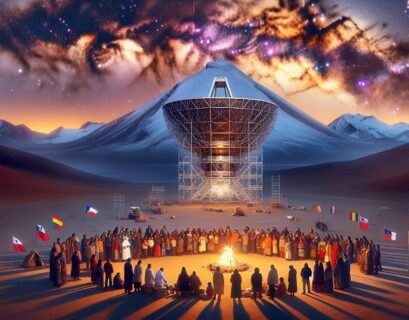General relativity is a theory that explains how gravity works in the universe. It was developed by Albert Einstein in the early 1900s and is still used today to understand the cosmos. This theory revolutionized our understanding of gravity and has had a profound impact on our understanding of the universe. While general relativity is a complex theory, it can be understood by anyone with an interest in the universe.
Key Takeaways
- General relativity is a theory that explains gravity as the curvature of spacetime.
- The mathematics of general relativity involves complex equations that describe the behavior of matter and energy in spacetime.
- General relativity has practical applications, such as in GPS technology and the detection of gravitational waves.
- Black holes are important in understanding general relativity. They are areas in spacetime. In these areas, gravity is extremely strong. Because of this strong gravity, nothing can escape from them.
General relativity and quantum mechanics are two theories. They try to explain the universe. However, they have not been fully reconciled yet.
The Basics of General Relativity: Understanding Spacetime and Gravity
General relativity says gravity isn’t a force. Instead, it’s about spacetime bending around big objects. Objects with mass bend spacetime. This bending makes other objects move closer. So, gravity comes from spacetime’s curve around big objects, not a pulling force.
Imagine a flat, stretched rubber sheet. Place a heavy object on it, and it will make a dent. Roll a smaller object close to the heavy one. The smaller object will move towards the dent. This shows how gravity works in general relativity. The heavy object is like a planet or star. The smaller object is something pulled by its gravity.
The Mathematics of General Relativity: Exploring the Equations
General relativity is a complex mathematical theory that involves equations and calculations. These equations explain how spacetime is curved and how objects move through it. The most famous equation in general relativity is Einstein’s field equations, which describe how matter and energy curve spacetime.
The field equations consist of ten equations. They connect spacetime curvature with how matter and energy are spread out in the universe. By solving these equations, we can figure out how objects behave under gravity. We also learn how spacetime bends around massive objects.
General relativity’s math can be tough. But, you can understand its basics without the hard equations. If you get how spacetime curves and influences object movement, you’ve got the core ideas of general relativity.
Applications of General Relativity: From GPS to Gravitational Waves
| Application | Description |
|---|---|
| GPS | General relativity is used to correct for time dilation effects in GPS satellites, which would otherwise cause errors in location calculations. |
| Gravitational Waves | General relativity predicts the existence of gravitational waves, which were first detected in 2015 and have since opened up a new field of astronomy. |
| Black Holes | General relativity provides the mathematical framework for understanding the behavior of black holes, including their event horizons and singularities. |
| Cosmology | General relativity is used to model the large-scale structure of the universe, including the expansion of space and the formation of galaxies. |
| Gravitational Lensing | General relativity predicts that massive objects can bend the path of light, allowing astronomers to observe distant objects that would otherwise be obscured. |
General relativity has many practical applications, including GPS technology and the detection of gravitational waves. GPS relies on the precise timing of signals from satellites, which are affected by the curvature of spacetime. Without taking general relativity into account, GPS would be inaccurate by several meters.
Gravitational waves are ripples in spacetime caused by the collision of massive objects, such as black holes or neutron stars. These waves were predicted by Einstein’s theory and were first detected in 2015. The detection of gravitational waves confirmed the existence of these waves and provided further evidence for the validity of general relativity.
Black Holes and General Relativity: Understanding the Unseen
Black holes are some of the most mysterious objects in the universe, and general relativity helps us understand them. They are formed when massive stars collapse, creating a singularity where the laws of physics break down.
General relativity explains how the extreme gravity of black holes warps spacetime and traps everything inside.
According to general relativity, black holes have an event horizon, which is a boundary beyond which nothing can escape. Anything that crosses this boundary is trapped inside the black hole’s gravitational pull. This is why black holes are often referred to as “cosmic prisons” from which nothing can escape, not even light.
The Theory of Relativity vs Quantum Mechanics: Two Theories of the Universe

General relativity is one of two major theories that explain the universe, the other being quantum mechanics. While general relativity explains gravity and the large-scale structure of the universe, quantum mechanics explains the behavior of particles on a small scale.
These two theories are highly successful in their respective domains, but they are incompatible with each other. This has led scientists to search for a theory of quantum gravity, which would unify general relativity and quantum mechanics into a single framework. However, finding a theory of quantum gravity has proven to be one of the biggest challenges in theoretical physics.
The Expanding Universe: How General Relativity Explains the Cosmos
General relativity explains how the universe expands. Edwin Hubble discovered this expansion in the 1920s. The theory shows that the universe grows faster over time because of dark energy.
Dark energy is a mysterious energy throughout space. It causes the universe to expand more quickly. General relativity helps us understand how dark energy changes spacetime’s shape and speeds up the universe’s expansion.
The Role of Light in General Relativity: Bending and Redshifting
General relativity changes how light acts. It can make light bend because space itself is curved. This bending was first seen in 1919 during a solar eclipse. Stars near the sun seemed to move from where they usually are. This was a big proof that general relativity was right.
General relativity also tells us about redshifting. This happens when light waves stretch out as they move through curved space. We see this as light from faraway galaxies turning more red. This shows us that the universe is getting bigger.
The Future of General Relativity: Advancements and New Discoveries
General relativity continues to be a major research topic. Scientists are busy improving the theory and making new discoveries. They are particularly interested in finding a theory of quantum gravity. Such a theory would combine general relativity and quantum mechanics. It aims to offer a full explanation of the universe. This includes everything from the tiniest particles to the biggest structures.
Another area of research is the study of dark matter and dark energy, which are still poorly understood. General relativity provides the framework to study these phenomena, but their nature and properties remain elusive. Understanding dark matter and dark energy is one of the biggest challenges in modern physics.
General Relativity Made Simple for Everyone
General relativity is a complex theory. However, anyone interested in the universe can understand it. We can explain spacetime, gravity, and the mathematics behind the theory. This helps us understand the cosmos and our place in it better.
General relativity has revolutionized our understanding of gravity and has had a profound impact on our understanding of the universe. It continues to be an active area of research, with scientists working to refine the theory and make new discoveries.
If you want to improve your physics knowledge, visit Entech Online. There, you’ll find many informative physics articles.
FAQs
What is general relativity?
General relativity is a theory of gravitation that was developed by Albert Einstein in 1915. It describes the gravitational force as a curvature of spacetime caused by the presence of mass and energy.
How does general relativity differ from Newton’s theory of gravitation?
Newton’s theory of gravitation sees gravity as a force. This force acts instantly between two objects. General relativity has a different view. It sees gravity as spacetime curving. This curvature happens because of mass and energy. So, gravity is not just a distant force. It is part of spacetime’s shape.
What are some of the predictions of general relativity?
General relativity predicts several phenomena. It says gravity can bend light. It also explains the small changes in Mercury’s orbit. Additionally, it predicts that light shifts to red due to gravity. Experiments have confirmed all these predictions.
What is the significance of general relativity?
General relativity is a key theory in physics. It helps us understand how gravity behaves and its impact on the universe. Thanks to this theory, we have technologies like GPS. GPS works by measuring time accurately and considering how gravity affects signals.
Is general relativity difficult to understand?
General relativity is a complicated theory. It combines advanced mathematics and physics. To understand it fully, one needs a strong knowledge in these areas. Yet, there are plenty of resources for those eager to learn more. These include books, online courses, and lectures.








